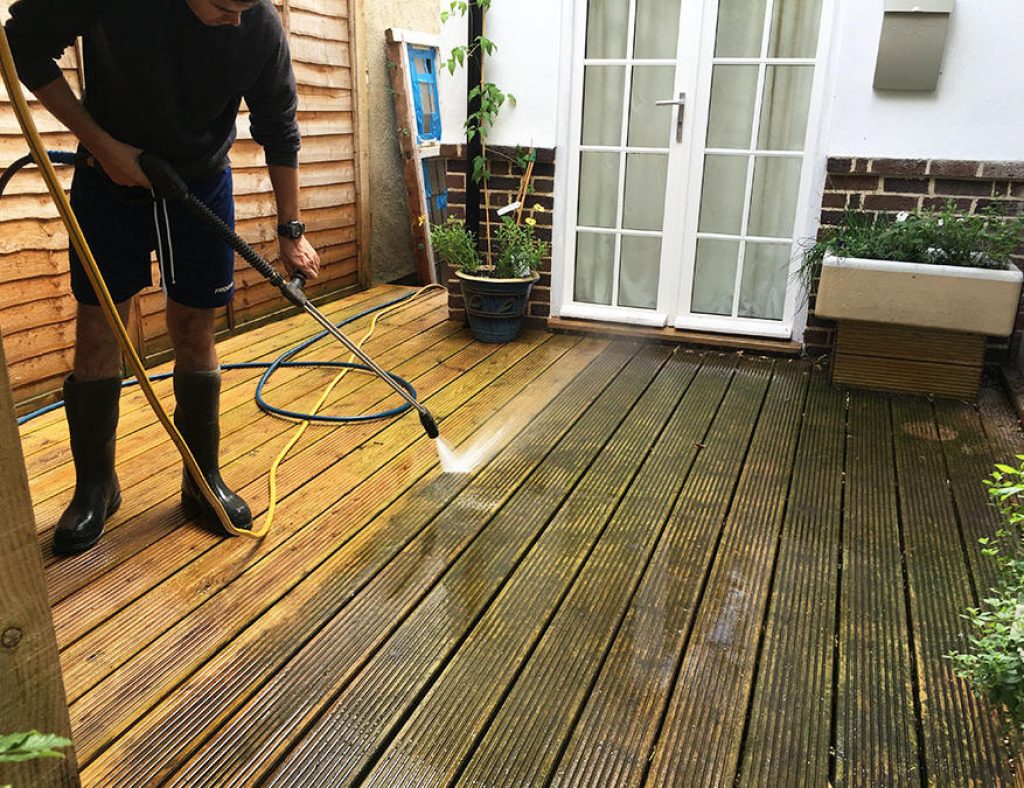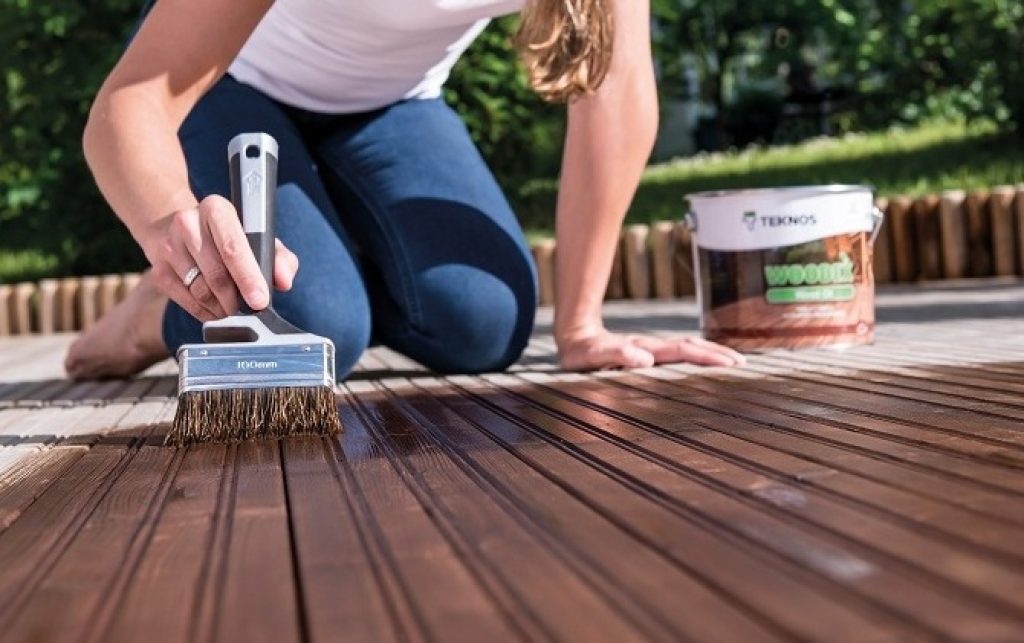




Compared to stone or concrete, wood reacts more sensitively to weathering. Rain and wind, sun, snow and ice cause the material to turn grey and can attack it in the long term. It is therefore crucial for a long life of the boards to clean and maintain your wooden terrace regularly.
How do I clean a wooden deck properly?
Weather influences and daily use leave traces on a wooden terrace: from a superficial grey film (patina) to small cracks in the boards. In the long term, moisture can penetrate there and form a breeding ground for fungi that damage the wood. This can be prevented by regular cleaning and subsequent maintenance of the decking. Use decking oil to protect the surface from cracks and moisture. This keeps the natural material resistant. A subsequent coat of paint refreshes the brown colour of the wood so that the patina disappears.
Remove coarse dirt and de-grey
We recommend that you thoroughly clean and maintain your wooden terrace about twice a year: after the winter in spring before the summer heat and in autumn in preparation for the cold season. The surface should be completely dry before cleaning. First, remove the coarse dirt from the terrace with a broom.
Then the garden hose is used: the wood should be completely wet when it is sprayed. If necessary, you can then apply a de-greaser evenly to the wooden floorboards using a paintbrush. After the reaction time recommended by the manufacturer, clean again with a brush or broom.
Remove green coating
A green coating on the wooden terrace increases the risk of accidents in wet weather conditions. This is because as soon as moisture settles on the lichen or moss, it becomes slippery on the wooden decking. This risk can be averted with green cover remover. But there are also home remedies and mechanical solutions that can be used to remove lichens and moss – and they are usually more environmentally friendly.
Remove green growth

Using water and washing-up liquid
Put a few squirts of dishwashing liquid in a bucket of hot water and stir until the liquid foams up. Then spread the water and detergent mixture generously over the floorboards. Clean the wet wood thoroughly with a hard-bristled broom or scrubbing brush. Then rinse the surface once with clean water.
Using soft soap
Soft soap can be applied undiluted to the decking boards and worked in with a brush or scrubber to remove dirt and green film. After cleaning, rinse the decking thoroughly with a garden hose or watering can.
Using soda
Soda ash has proven to be a practical and inexpensive household aid for cleaning wooden patios. The powder is available at the drugstore. For encrusted dirt, simply mix some of the powder with water and apply the mixture directly to the decking boards with a brush. Allow the mixture to work for about three hours and then brush the boards completely with clean water.
Use of the pressure washer

The use of a pressure washer is not suitable for all types of wood. With soft softwoods such as larch or Douglas fir, it is generally advisable to avoid this procedure, as the water pressure can damage the surface of the decking. With hardwoods such as bamboo, bangkirai or kempas, on the other hand, dirt can be removed more easily by machine.
If the pressure washer is used, proceed with caution: First, mount the decking attachment and set the water pressure low. If the pressure is too high and you do not use the special attachment, the wood can be damaged. For example, the fibres could stand up and make the surface rough and splintery.
It is important to clean the entire surface so that it has a uniform colour. Then the terrace must first dry for at least 24 hours. This procedure prevents moisture from remaining in the wood. This can cause the boards to rot under the subsequent maintenance layer of oil.
Care: Oil

In addition to regular cleaning, wooden decking also needs care. Treating the planks with a suitable oil makes sense to prevent cracks in the surface and at the same time to prevent a grey patina from forming.
A transparent oil is recommended if the colour of the material is to remain unchanged. Coloured products, such as a naturally tinted Douglas fir oil, bring out the original wood tone more clearly.
The products smooth the surface of the planks and surround them with a protective layer that is water and dirt repellent. Unsuitable for the care of decking boards, on the other hand, are wood preservative stains and varnishes. They flake off quickly due to frequent use.
When oiling the boards, it should be as windless and cloudy as possible. Such weather conditions ensure that the products can penetrate deep into the wood. This is because the surface dries too quickly in intense sunlight.
When oiling, you should take about three to four boards in succession and apply the maintenance oil with a brush or a short-haired roller. When the oil has been absorbed, repeat the process and treat the entire floor step by step. The wood care product should be allowed to soak in for at least 24 hours before the next use of the terrace.
Regularly remove dirt
Until the next basic cleaning, it is sufficient to sweep off the floorboards completely at regular intervals. When doing so, it is crucial to remove leaves, bird droppings and other dirt thoroughly, as they can cause discolouration on the wood. If stubborn stains have already appeared, you can usually remove them with a brush and some soap or use special patio cleaner. If weathered spots appear on the wooden planks over the course of the year, it makes sense to re-oil the affected planks separately. This saves time and effort during the next basic cleaning.
Which wood is suitable for the terrace?
The amount of maintenance required also depends on the choice of wood for your terrace. Planks made of tropical woods such as teak or bangkirai are very popular. These rather expensive types of wood are resistant to insect infestation and rot. In addition, the dark colour has a noble effect.
Teak and Bangkirai do turn grey over time without care, but they do not lose their hardness. If you don’t mind the colour change, the maintenance effort is therefore limited. If you decide to use these types of wood, make sure to buy certified products from sustainable forestry, which you can recognise by the FSC seal, for example.
Often cheaper and more sustainable are decking boards made from domestic woods. Pressure impregnated spruce or pine are suitable. Douglas fir or larch are also comparatively resistant to weathering. Untreated, however, domestic woods do not come close to the durability of tropical woods. However, their durability can be increased by certain methods.
For this purpose, the wood is either soaked in wax (durable wood) or treated with bio-alcohol in a special process (Kebony). After drying, the alcohol hardens into polymers and makes the wood very durable. A third option for improving durability is heat treatment (thermowood).


